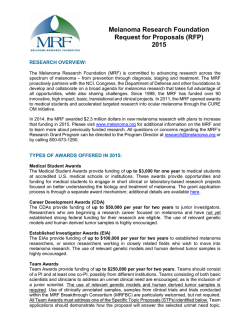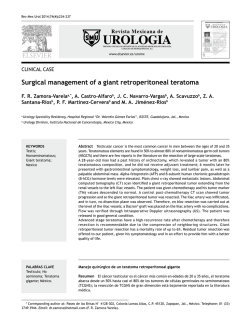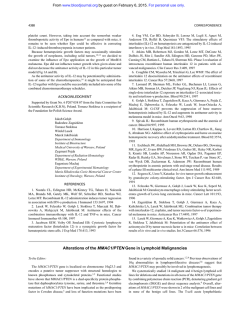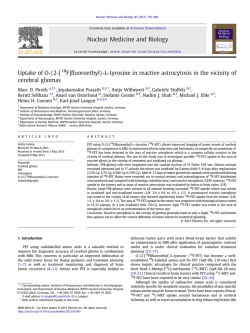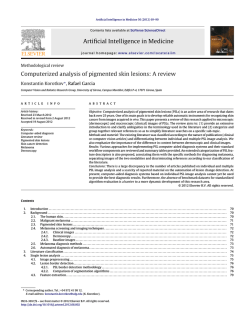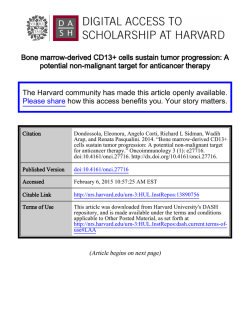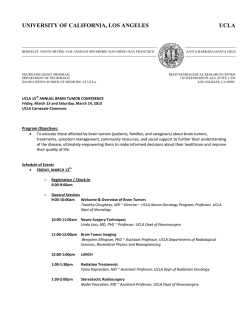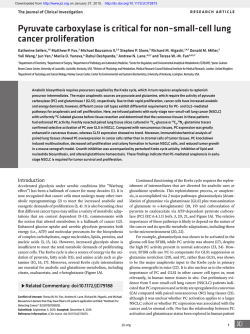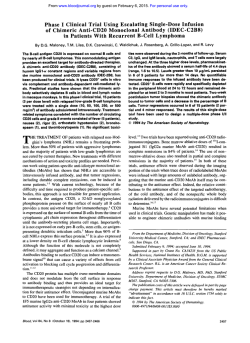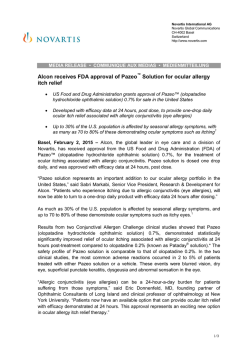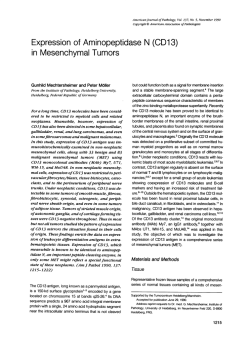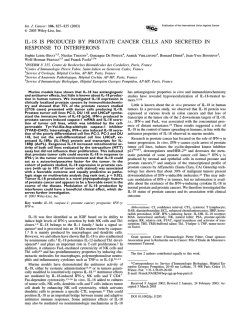
Dr. John B. Davies
1/28/2015 OBJECTIVES • Provide a brief review of cancer epidemiology • Discuss the clinical evaluation of ocular melanocytic VRS RETINAL UPDATE: tumors CHOROIDAL MELANOMA • Highlight new developments in gene expression profiling f for choroidal melanoma • Class 1 - lower risk of metastasis • Class 2 - higher risk of metastasis John B. Davies, MD January 31, 2015 • Discuss case examples NUMBERS OF SURVIVORS FOR THE MOST COMMON CANCERS IN THE US AS OF JANUARY 2014 MALES FEMALES PROSTATE 2,975,970 BREAST 3,131,440 COLON / RECTUM 621,430 UTERINE 624,890 MELANOMA 516,570 COLON / RECTUM 624,340 BLADDER 455,520 MELANOMA 528,860 ALL SITES 6,876,600 ALL SITES 7,607,230 Cancer Treatment & Survivorship Facts and Figures 2014-2015, American Cancer Society American Cancer Society American Cancer Society American Cancer Society 1 1/28/2015 CANCER STATISTICS MALES RISK OF DEVELOPING (%) RISK OF DYING FROM (%) PROSTATE 15.0 2.7 7.4 LUNG 1 IN 13 4.8 COLON 1 IN 20 BLADDER ALL SITES American Cancer Society 1 IN 7 3.8 1 IN 26 43.3 6.5 2.0 0.9 22.8 US National Cancer Institute’s Surveillance Epidemiology and End Results (SEER) Database, 2009-2011 CANCER STATISTICS FEMALES RISK OF DEVELOPING (%) RISK OF DYING FROM (%) BREAST 12.3 2.7 1 IN 8 6.2 LUNG 4.7 1 IN 16 4.5 COLON 1.9 1 IN 22 UTERINE ALL SITES 2.7 0.6 1 IN 37 37.8 OUR FOCUS TODAY: CHOROIDAL MELANOMA 19.3 US National Cancer Institute’s Surveillance Epidemiology and End Results (SEER) Database, 2009-2011 CHOROIDAL MELANOMA • Most common primary intraocular tumor in adults • Incidence in the US: 6 to 7 cases per million • Affects 1,200 - 1,500 people in the US each year • Usually diagnosed in the sixth decade of life • Most cases are sporadic without a positive family history of the disease CHALLENGES • Despite many advances in the diagnosis and treatment, there has not been a corresponding improvement in survival rates • Early micro-metastasis have already occurred before treatment of the primary tumor • Prolonged latency before the metastatic disease manifests itself 2 1/28/2015 CHOROIDAL MELANOMA: RISK FACTORS OCULAR MELANOCYTOSIS • Caucasian race • Light iris color (blue or gray) • Cutaneous C t nevi,i atypical t i l cutaneous t nevi,i ffreckles, kl iiris i nevii • Other melanocytic conditions • Ocular melanocytosis • Oculodermal melanocytosis (nevus of Ota) • ? sunlight exposure, welding OCULODERMAL MELANOCYTOSIS (NEVUS OF OTA) SITES OF OCULAR INVOLVEMENT • Uveal tract: 95% • Choroid - most common • Ciliary body • Iris • Other sites (conjunctiva): 5% PATHOLOGY PATHOLOGY 3 1/28/2015 CELL TYPES PRESENTATION • Location and size determine presenting symptoms • Peripheral lesions may go undetected for a • Spindle A long time • Spindle B • Posterior lesions may lead to visual changes early on • Epithelioid • Ciliary body tumors may displace the iris or lead to • Mixed sectoral cataracts • May erode through the iris or sclera CLINICAL FEATURES CLINICAL FEATURES • Brown, elevated, dome shaped mass • Variable degree of pigmentation • Orange lipofuscin pigment • Subretinal fluid • May break through Bruch’s membrane leading to a collar-button or mushroom-shaped configuration ULTRASONOGRAPHY Anterior CHOROIDAL NEVI Posterior • Benign melanocytic uveal lesions • Typically found on routine dilated B Scan fundus exam • Usually asymptomatic • In the United States, prevalence A Scan Low internal reflectivity ranges from 4.6 to 7.9% in Caucasians 4 1/28/2015 DISTINGUISHING FEATURES NEVUS • Clearly defined margins • Flat or slightly elevated • Associated drusen • Remains stable in size CHOROIDAL NEVI: NATURAL HISTORY MELANOMA • Indiscrete margins • Risk of malignant transformation: 1 in 8,845 • More elevated • Increased risk with age: • Subretinal fluid • Orange pigment • Growth • By age 80, risk of transformation is 0.78% Singh, Ophthalmology 2005 Kivela, Ophthalmology 2006 “TO FIND SMALL OCULAR MELANOMA USING HELPFUL HINTS DAILY” RISK FACTORS FOR MALIGNANCY • Thickness > 2 mm • Fluid • Symptoms • Orange pigment • Margin within 3 mm of optic disc “To Find Small Ocular Melanoma Using Helpful Hints Daily” RISK FACTORS RISK OF GROWTH AT 5 YEARS (%) MANAGEMENT 0 3 OBSERVE 1 38 OBSERVE Q 4-6 MONTHS 3 OR MORE >50 CONSIDER TREATMENT • Ultrasonographic Hollowness • Absence of Halo • Absence of Drusen MANAGEMENT OF INTERMEDIATE RISK LESIONS TREATMENT • Radiation • Plaque brachytherapy • External beam radiation therapy • Enucleation • Photographic and ultrasonographic / OCT documentation • Transpupillary Thermal Therapy (TTT) • Periodic reassessment for signs of growth 5 1/28/2015 PLAQUE BRACHYTHERAPY COLLABORATIVE OCULAR MELANOMA STUDY (COMS) • Small tumor trial - observational • Medium tumor trial - enucleation vs. brachytherapy • Large tumor trial - enucleation vs. enucleation + external beam radiation COMS: SMALL TUMOR STUDY OBSERVATION 204 PATIENTS 5 YEAR ALL CAUSE MORTALITY (%) 5 YEAR MORTALITY W ITH METASTATIC MELANOMA (%) 6 1 • Features predictive of tumor growth: • Increased tumor thickness and diameter, orange pigment, absence of drusen, absence of adjacent RPE changes, pinpoint hyperfluorescence on angiography COMS: MEDIUM TUMOR STUDY ENUCLEATION 660 PATIENTS IODINE-125 BRACHYTHERAPY 5 YEAR ALL CAUSE MORTALITY (%) 5 YEAR MORTALITY W ITH METASTATIC MELANOMA (%) 19 11 18 9 COMS: MEDIUM TUMOR STUDY 657 PATIENTS 6 1/28/2015 COMS: LARGE TUMOR STUDY MOLECULAR CLASSIFICATION OF UVEAL MELANOMA • Similar survival regardless if patients were treated with external beam radiation or not prior to enucleation • Gene expression profiling can identify patients at high risk for metastasis 5 YEAR ALL CAUSE MORTALITY (%) ENUCLEATION 506 PATIENTS EXTERNAL RADIATION + ENUCLEATION • Commercially available test: DecisionDx-UM, an expression profile of 15 genes 43 • Tumor sample obtained from small-gauge needle 38 biopsy 497 PATIENTS MOLECULAR CLASSIFICATION OF UVEAL MELANOMA MOLECULAR CLASSIFICATION OF UVEAL MELANOMA • Class 1 - lower risk of metastasis • Offer individualized management • Genes expressed p are more similar to normal uveal melanocytes • Class 2 - higher risk of metastasis • Genes expressed are similar to primitive, undifferentiated cells PROGNOSTIC POWER OF GENE EXPRESSION PROFILING • Prognosis • Metastatic surveillance • Clinical trial opportunities • Ultimate goal: improve patient outcomes DRIVER MUTATIONS IN UVEAL MELANOMA CLASS 1 CLASS 2 GNAQ / GNA11 BAP1 SF3B1 EIF1AX 7 1/28/2015 GNAQ / GNA11 BAP1 • Tumor suppressor gene, chromosome 3p21 • Oncogenes: disable GTPase activity leading to constitutive activation of cell signaling pathways • Found in premalignant nevi and uveal melanoma of all stages • Thought to be an early initiating event in tumorigenesis but not necessarily sufficient for the development of a metastatic tumor SF3B1 • Removes ubiquitin from substrates • Roles in gene expression, cell cycle regulation, cellular identity • Found in the majority of Class 2 tumors, rarely in Class 1 • In most metastasizing Class 2 tumors, one copy of BAP1 is mutated and the other is absent through loss of the entire chromosome (strong relationship between Class 2 tumors and monosomy 3) EIF1AX • Splicing Factor 3B Subunit 1 • Eukaryotic Translation Initiation Factor 1A, 1A X-linked • Alters mRNA splicing • Associated with Class 1 tumors • Associated with Class 1 tumors 8 1/28/2015 71 YO ♀ WITH A CHOROIDAL TUMOR • Worsening vision OD x 1 year • Choroidal lesion not previously noted on past diabetic eye exams • 20/30 OD, 20/25 OS B SCAN IMPRESSION / PLAN 66 YO ♂ WITH A CHOROIDAL TUMOR • Choroidal melanoma • Exudative retinal detachment • Enucleation vs. plaque brachytherapy vs. external beam radiation • First told of a nevus in the right eye 6 years ago • No vision changes • 20/30 OD, 20/20 OS • Class 1 9 1/28/2015 B SCAN 79 YO ♀: AMD AND WORSENING VA OD IMPRESSION / PLAN • 2008: VA OD 20/25 • Intermediate risk choroidal melanocytic tumor • Observation • 2011: VA OD 20/100 • History of colon cancer in 2006 s/p surgery and chemotherapy 20/100 20/20 10 1/28/2015 • Angiographic features consistent with occult choroidal neovascularization • Begin treating with Avastin • After first injection, VA improved to 20/30 • Variable SRF over subsequent months, 4 total Avastin injections • Macular lesion continues to enlarge • Concern for choroidal mass: metastatic colon cancer vs. amelanotic melanoma? 2011 2011 2013 2013 11 1/28/2015 • Systemic work-up unremarkable • PET scan: negative for metastasis • Diagnosis: subfoveal amelanotic choroidal melanoma • June 2013: brachytherapy with 16 mm plaque • Exudative retinal detachment CONCLUSIONS CONCLUSIONS • Risk factors growth of choroidal nevi and malignant transformation: “To • Prostate and breast cancer account for the most new cases of cancer in the US in men and women, respectively • Lung cancer accounts for the most cancer-related deaths in both men and women • Choroidal melanoma is the most common primary intraocular malignancy in adults Find Small Ocular Melanoma Using Helpful Hints Daily” • Thickness > 2 mm, Fluid, Symptoms, Orange pigment, Margin within 3 mm of optic disc, Ultrasonographic Hollowness, absence of Halo, absence of Drusen • Gene expression profiling predicts the risk of metastasis • Class 1 - lower risk • Class 2 - higher risk • Our understanding of the mutations that drive the development of ocular melanoma may lead to targeted therapy in the future and improved patient outcomes. 12
© Copyright 2026

